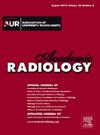HRS Improves Active Surveillance for Prostate Cancer by Timely Identification of Progression
IF 3.9
2区 医学
Q1 RADIOLOGY, NUCLEAR MEDICINE & MEDICAL IMAGING
引用次数: 0
Abstract
Rationale and Objectives
Active surveillance (AS) is the preferred management strategy for low-risk prostate cancer. This study aimed to evaluate the impact of Habitat Risk Score (HRS), an automated approach for mpMRI analysis, for early detection of progressors in a prospective AS clinical trial (MAST NCT02242773).
Materials and Methods
The MAST protocol includes Confirmatory mpMRI ultrasound fusion (MRI-US) biopsy and yearly surveillance MRI-US biopsies for up to 3 years. Clinical and mpMRI data from patients that progressed based on protocol criteria at years 1–3 were reviewed. Patients were classified as “MRI/HRS Progressors” if the PI-RADS lesion(s) had been targeted throughout the surveillance and resulted in positive biopsies, or as "Missed Progressors" if the lesion(s) were not identified by PI-RADS (“PI-RADS Miss”) or were missed by the biopsy (“Needle Miss”). HRS maps were generated for each patient and evaluated for association with histopathological progression.
Results
Of the 34 patients, 15 were classified as “MRI/HRS Progressors” and 19 as "Missed Progressors" (12 "PI-RADS Miss", seven "Needle Miss"). In all cases, HRS confirmed the PI-RADS assessment. In the "PI-RADS Miss" group, HRS identified the lesions in all patients that were not targeted by biopsy and resulted in patient reclassification. HRS volumes showed clear association with tumor evolution both in terms of volume and aggressiveness over time.
Conclusion
HRS volumes can serve as a quantitative biomarker for early detection of progression and lead to timely conversion to treatment, thereby improving patient outcomes and reducing the burden of unnecessary surveillance.
HRS通过及时识别进展改善前列腺癌的主动监测。
理由和目的:主动监测(AS)是低风险前列腺癌首选的治疗策略。本研究旨在评估栖息地风险评分(HRS),一种用于mpMRI分析的自动化方法,在前瞻性AS临床试验(MAST NCT02242773)中早期检测进展者的影响。材料和方法:MAST方案包括验证性mpMRI超声融合(MRI-US)活检和每年监测MRI-US活检,为期3年。回顾了1-3年根据方案标准进展的患者的临床和mpMRI数据。如果PI-RADS病变在整个监测过程中都是靶向的,并且活检呈阳性,则将患者分类为“MRI/HRS进展者”,如果PI-RADS未发现病变(“PI-RADS遗漏”)或活检未发现病变(“穿刺遗漏”),则将患者分类为“遗漏进展者”。为每位患者生成HRS图,并评估其与组织病理进展的关系。结果:34例患者中,MRI/HRS进展者15例,进展漏诊者19例(PI-RADS漏诊12例,针刺漏诊7例)。在所有情况下,HRS都确认了PI-RADS评估。在“PI-RADS Miss”组中,HRS识别了所有活检未靶向的患者病变,并导致患者重新分类。随着时间的推移,HRS体积在体积和侵袭性方面都显示出与肿瘤进化的明确关联。结论:HRS体积可以作为早期发现进展的定量生物标志物,及时转化为治疗,从而改善患者预后,减轻不必要的监测负担。
本文章由计算机程序翻译,如有差异,请以英文原文为准。
求助全文
约1分钟内获得全文
求助全文
来源期刊

Academic Radiology
医学-核医学
CiteScore
7.60
自引率
10.40%
发文量
432
审稿时长
18 days
期刊介绍:
Academic Radiology publishes original reports of clinical and laboratory investigations in diagnostic imaging, the diagnostic use of radioactive isotopes, computed tomography, positron emission tomography, magnetic resonance imaging, ultrasound, digital subtraction angiography, image-guided interventions and related techniques. It also includes brief technical reports describing original observations, techniques, and instrumental developments; state-of-the-art reports on clinical issues, new technology and other topics of current medical importance; meta-analyses; scientific studies and opinions on radiologic education; and letters to the Editor.
 求助内容:
求助内容: 应助结果提醒方式:
应助结果提醒方式:


